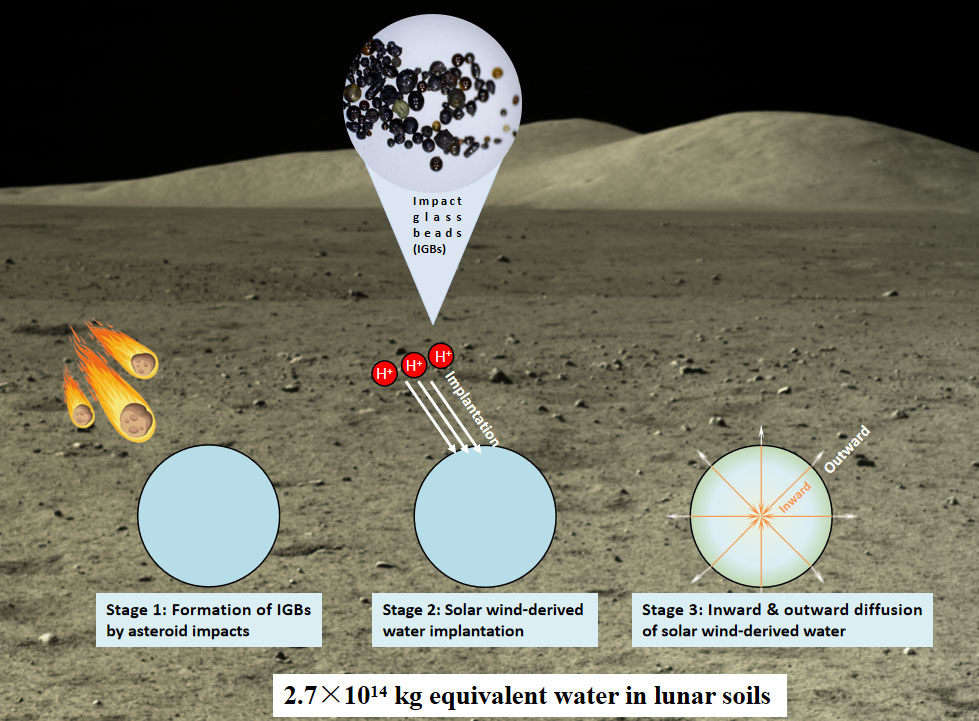| Mar 28, 2023 |
Researchers find new water reservoir on Moon
|
|
(Nanowerk News) The lunar surface's water has garnered significant interest due to its potential for in-situ resource utilization in future lunar explorations and other space missions.
|
|
A team of researchers, led by Professor HU Sen from the Institute of Geology and Geophysics (IGG) at the Chinese Academy of Sciences, discovered that impact glass beads present in the Chang'e-5 (CE5) lunar soil samples contain water.
|
|
In-depth analysis reveals that these glass beads may constitute a new water reservoir on the Moon, reflecting the dynamic flow of water derived from solar winds and serving as a stabilizing component in the lunar surface water cycle.
|
|
The findings were published in Nature Geoscience ("A solar wind-derived water reservoir on the Moon hosted by impact glass beads").
|
 |
| A schematic diagram of the lunar surface water cycle associated with impact glass beads. (Image: Prof. HU Sen's group)
|
|
Numerous lunar missions have confirmed the existence of structural water or water ice on the Moon. While the Moon's surface undoubtedly contains water, the amount is considerably less than on Earth.
|
|
Lunar surface water exhibits diurnal cycles and loss to space, suggesting the presence of a hydrated layer or reservoir within lunar soils that maintains and replenishes surface water. However, prior research on fine mineral grains, impact-generated agglutinates, volcanic rocks, and pyroclastic glass beads in lunar soils has not explained the lunar surface water cycle's retention, release, and renewal processes. This implies the existence of an unidentified water reservoir in lunar soils capable of stabilizing the lunar surface water cycle.
|
|
Doctoral candidate HE Huicun, under the supervision of Prof. HU Sen, suggested that impact glass beads, an amorphous and ubiquitous component in lunar soils, could be the unidentified hydrated layer or reservoir.
|
|
HE Huicun conducted a systematic study of the petrography, major element composition, water content, and hydrogen isotope composition of the impact glass beads returned by the CE5 mission, with the aim of identifying and characterizing the elusive water reservoir on the lunar surface.
|
|
The CE5 impact glass beads exhibit uniform chemical compositions and smooth exposed surfaces. They are marked by water content of up to approximately 2,000 µg/g and extremely deuterium-depleted characteristics. The negative correlation between water content and hydrogen isotope composition indicates that the water in the CE5 impact glass beads originates from solar winds.
|
|
The researchers also analyzed water content across six transects in five glass beads, revealing the hydration profiles of solar wind-derived water. Some glass beads were affected by a subsequent degassing event. The impact glass beads function as a sponge, buffering the lunar surface water cycle. The researchers estimate that the water contributed by impact glass beads to lunar soils ranges from 3.0 x 1011 kg to 2.7 x 1014 kg.
|
|
Prof. HU noted, "These findings suggest that the impact glasses on the Moon's surface and other airless celestial bodies in the solar system have the capacity to store solar wind-derived water and release it into space."
|

